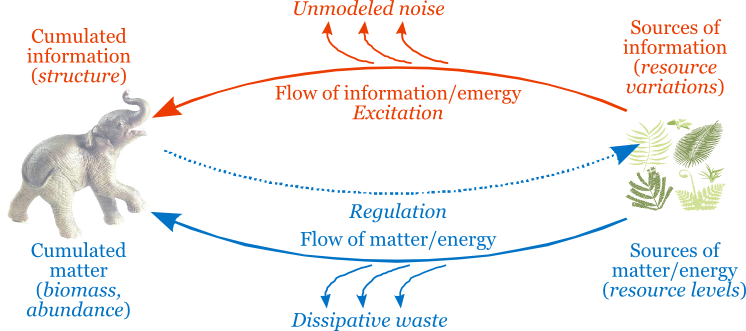
Simulation of Neocybernetic Ecosystems
by Heikki HyötyniemiJava-application »
Instructions »
The simulation was implemented by Mr. Jan Tiri and Mr. Seokpum Kim in summer 2008Typically, building of models starts from the bottom, from the elementary first principles. When such models are combined, the whole system model does no more behave in a reasonable way – truly, the whole is more than a sum of the parts. There are interactions among the components that determine the properties of the networked system. Now, the system model is constructed starting directly from the system level intuition.
Neocybernetics offers a framework for looking at systems as a whole. Yet, in that framework all signal manipulations and parameter adaptations are completely local. The only rule that the underlying “agents” are assumed to follow is try to go towards available resources. It turns out that the population evolves to better exhaust the resources that are available in the environment. According to the Darwinian principle, the most optimal (or the most cybernetic!) population is strongest and it survives. As the resources vary from year to year, developments are rather random – but when time goes on, experiences cumulate in the system’s “memory”.
The above learning principle sounds very simple, and, indeed, the actual clue is in the two-way coupling between the system and its environment. As an individual exploits resources it simultaneously exhausts them; this means that there is a negative feedback through the environment, resulting in self-regulation and self-organization of the system. In mathematical terms, this self-organization means that the principal subspace is spanned by the species that start representing the sparse components in the observation data. As the degrees of freedom in resource variations are captured in the best possible way, the system can be seen to extract patterns in the data. The “species” that the formed ecosystem is composed of are not unique – but the spectrum of their properties reflect the structure of the environmental resources in a more or less balanced way.
The adapted ecosystem has some emergent properties that are seemingly contradictory. However, everything can be explained in terms of information, or correlations in variations:
- There is volatility of signals, but stability of structures. One could say that there is a higher-level balance, or fractal hierarchy of balances.
- There is robustness against noise, but sensitivity towards information. This dichotomy makes it possible to explain biodiversity and emerging niches.
- There is elimination of information in the environment, but maximization of information in populations. Such relaying of resources results in the emergence of trophic layers.
- There is emphasis on freedoms, but in evolution the system becomes stiffer. Variability is valued but competition results in more and more stringent controls.
More philosophically speaking, one could say that the opposite views result in a new dualism, where the material and immaterial worlds are coupled. The information (variations in resources) determines the forms in the visible world, whereas matter and energy (levels in resources) determine the actual biomasses. Further evolution in the system is understandable in terms of new innovations changing uncorrelated noise into relevant information. Indeed – it seems that neocybernetics offers a paradigm for understanding life in general, also in non-biological phenospheres.

A publication on neocybernetic populations, published at SIMS’06 (47th Conference on Simulation and Modelling, 28–29 September 2006, in Helsinki).
